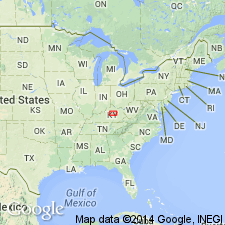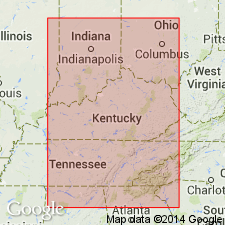
- Usage in publication:
-
- Tanglewood Limestone Member*
- Modifications:
-
- Named
- Dominant lithology:
-
- Limestone
- AAPG geologic province:
-
- Cincinnati arch
Summary:
Named as a member of Lexington Limestone. Named for Tanglewood, a suburb of Frankfort, Franklin Co., KY. Characterized by calcarenite, much of which is phosphatic, composed predominately of subrounded skeletal fragments, ranging from fine to coarse sand and generally cemented by sparry calcite. Its bedding character is somewhat variable, though bedding surfaces are commonly smooth and cross bedding in common. Total thickness at type section is 61 ft. At type section, underlain by the Brannon Member, overlain by Clays Ferry Formation. At type section, Tanglewood is divided into two parts by a 10-foot thick intercalation of Devils Hollow Member.
Source: GNU records (USGS DDS-6; Reston GNULEX).

- Usage in publication:
-
- Tanglewood Limestone Member*
- Modifications:
-
- Overview
- AAPG geologic province:
-
- Cincinnati arch
Summary:
The Tanglewood Limestone Member of the Lexington Limestone consists of pinkish-gray, cross-bedded, phosphatic, medium-grained, well-sorted, bioclastic calcarenite that contains bryozoans, brachiopods, and crinoids. Thickness is 60 to 100 feet. Overlies and intertongues with the Grier Limestone Member, intertongues with the Perryville Member, Brannon Member, Devils Hollow Member, and Millersburg Member, all of the Lexington Limestone, and underlies and intertongues with the Sulphur Well Member of the Lexington Formation and the Clays Ferry Formation. The Tanglewood is interpreted to be deposited in a tidal environment.
Source: GNU records (USGS DDS-6; Reston GNULEX).

- Usage in publication:
-
- Tanglewood Limestone Member*
- Modifications:
-
- Age modified
- AAPG geologic province:
-
- Cincinnati arch
Summary:
Figure 3 shows that Tanglewood Limestone Member of Lexington Limestone is Champlainian (Shermanian) in age, but boundary between Shermanian and Edenian Stages (and therefore the top of the Tanglewood), is queried.
Source: GNU records (USGS DDS-6; Reston GNULEX).
For more information, please contact Nancy Stamm, Geologic Names Committee Secretary.
Asterisk (*) indicates published by U.S. Geological Survey authors.
"No current usage" (†) implies that a name has been abandoned or has fallen into disuse. Former usage and, if known, replacement name given in parentheses ( ).
Slash (/) indicates name conflicts with nomenclatural guidelines (CSN, 1933; ACSN, 1961, 1970; NACSN, 1983, 2005, 2021). May be explained within brackets ([ ]).

